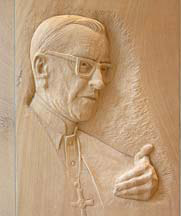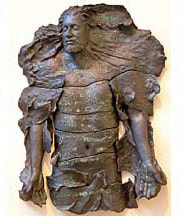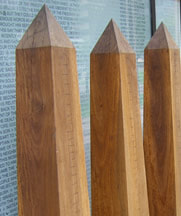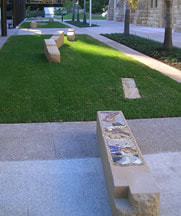The Francis Rush CentreSee Also:
The Francis Rush Centre brings to completion the restoration of the Cathedral Precinct. Situated beside the Cathedral (view precinct map), the Centre comprises of four levels – two below the level of the Cathedral grounds and two above.
The key elements of the design include:
This building enhances not only the liturgical and pastoral life of the Cathedral but the life of the city as well. Archbishop John Bathersby DD officially blessed and opened the Centre on Sunday 11 September 2005. Francis Rush Centre Works of ArtThe Francis Rush Centre, and its surroundings, includes a number of works of art by artists Rhyl Hinwood, Thomas Justice and Judy Watson. These are described in detail below.
|
FRANCIS ROBERTS RUSH
Sandstone relief by Rhyl Hinwood, 2005, lower foyer
Francis Rush (1916-2001) was Archbishop of Brisbane between 1973 and 1991. A powerful preacher, a sharp intellect, a voracious reader, a wise pastor, and a dynamic leader, his life and ministry was shaped by the vision of the Second Vatican Council (1962-1965). His episcopal motto was Life to me is Christ (Phil 1:21).
Sandstone relief by Rhyl Hinwood, 2005, lower foyer
Francis Rush (1916-2001) was Archbishop of Brisbane between 1973 and 1991. A powerful preacher, a sharp intellect, a voracious reader, a wise pastor, and a dynamic leader, his life and ministry was shaped by the vision of the Second Vatican Council (1962-1965). His episcopal motto was Life to me is Christ (Phil 1:21).
CREDO
Bronze sculpture by Thomas Justice, 2005, upstairs foyer
In passing beyond suffering and death, the risen Christ embarks on a living journey through the ages. He is alive in the community of faith which profess the words of the Creed, handed on from generation to generation of believers. The transformation of the resurrection is revealed in the image of the gum tree whose bark splits, peels back and hangs in shards. In baptism we cast of the old for the new and share the communion of the risen Christ.
Bronze sculpture by Thomas Justice, 2005, upstairs foyer
In passing beyond suffering and death, the risen Christ embarks on a living journey through the ages. He is alive in the community of faith which profess the words of the Creed, handed on from generation to generation of believers. The transformation of the resurrection is revealed in the image of the gum tree whose bark splits, peels back and hangs in shards. In baptism we cast of the old for the new and share the communion of the risen Christ.
EMPIRE STAKES
Ironbark Posts and steel plates by Judy Watson, 2003, foyer entrance
In 1852, ironbark posts were placed at intervals along the boundaries of the one square mile of the Brisbane Town settlement. A curfew excluded undesirable or disorderly persons from the town after dark, a provision which included aboriginal people. Aboriginal artist, Judy Watson, has taken this symbol of exclusion and, by grouping them together, shows that there is no exclusion zone, that this is a place of welcome, justice and respect for all.
Ironbark Posts and steel plates by Judy Watson, 2003, foyer entrance
In 1852, ironbark posts were placed at intervals along the boundaries of the one square mile of the Brisbane Town settlement. A curfew excluded undesirable or disorderly persons from the town after dark, a provision which included aboriginal people. Aboriginal artist, Judy Watson, has taken this symbol of exclusion and, by grouping them together, shows that there is no exclusion zone, that this is a place of welcome, justice and respect for all.
RIVER OF STONE
Carved sandstone blocks by Rhyl Hinwood, Mosaics by Scott Harrower, 2005, garden
The thirty monumental stone slabs forming the River of Stone establish a narrative thread through the site, telling the story of St Stephen, first martyr and patron of the cathedral. The account from the Acts of the Apostles is engraved on the glass panels along the length of the building. Key words from the story are carved in the blocks of the River of Stone.
The story begins at the Charlotte Street end with the appointment of seven deacons to care for those in need. The carved relief shows the separation of the seven, specially highlighting the pre-eminence of Stephen.
The second central zone refers to the powerful preaching of Stephen and his inspired explanation of the Gospel of Christ. The carved relief – the earth as God’s footstool – marks out in gold the ongoing history of God’s providence.
The final part of the narrative encircles the celebration space at the Elizabeth Street end. Chunks taken from each slab recall the stoning of Stephen (they form a cross in the centre of the pavement). The carved relief depicts the martyr’s palm branch of victory and the gold of the glimpse of heaven.
Near the gathering space one stone bears a mosaic panel showing all three of these phases in the Stephen story: his works of charity, his fearless preaching, and his martyrdom.
Carved sandstone blocks by Rhyl Hinwood, Mosaics by Scott Harrower, 2005, garden
The thirty monumental stone slabs forming the River of Stone establish a narrative thread through the site, telling the story of St Stephen, first martyr and patron of the cathedral. The account from the Acts of the Apostles is engraved on the glass panels along the length of the building. Key words from the story are carved in the blocks of the River of Stone.
The story begins at the Charlotte Street end with the appointment of seven deacons to care for those in need. The carved relief shows the separation of the seven, specially highlighting the pre-eminence of Stephen.
The second central zone refers to the powerful preaching of Stephen and his inspired explanation of the Gospel of Christ. The carved relief – the earth as God’s footstool – marks out in gold the ongoing history of God’s providence.
The final part of the narrative encircles the celebration space at the Elizabeth Street end. Chunks taken from each slab recall the stoning of Stephen (they form a cross in the centre of the pavement). The carved relief depicts the martyr’s palm branch of victory and the gold of the glimpse of heaven.
Near the gathering space one stone bears a mosaic panel showing all three of these phases in the Stephen story: his works of charity, his fearless preaching, and his martyrdom.






